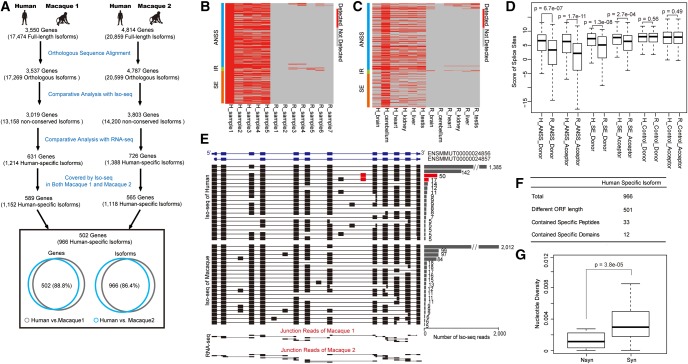Fig. 5.
Identification and verification of genes encoding isoforms specific to human. (A) Diagram showing the comparative transcriptome study in human on the basis of both PacBio Iso-seq and RNA-seq data. (B) Heatmap showing the status of the candidate human lineage-specific events in multiple human individuals and macaque animals. (C) Heatmap showing the status of the candidate human lineage-specific events in multiple tissues between human and rhesus macaque. Red: observed events; Gray: events not detected. (D) Cis-features for lineage-specific alternative RNA processing events in human. The splice site score of each lineage-specific splice site in human and rhesus macaque was calculated and shown. For lineage-specific A5SS and A3SS events detected in human only, the splice score in human (H_ANSS_Donor and H_ANSS_Acceptor) are significantly higher than that in rhesus macaque (R_ANSS_Donor and R_ANSS_Acceptor). For lineage-specific exon skipping events detected in human only, the splice score for 5′ and 3′ splice sites in human (H_SE_Donor and H_SE_Acceptor) are significantly higher than that in rhesus macaque (R_SE_Donor and R_SE_Acceptor). For lineage nonspecific exon skipping events detected in both human and rhesus macaque, the splice scores are generally comparable in the two species. (E) Validation of isoforms specific to human in PIGU gene using ultradeep targeted Iso-seq sequencing. Isoforms with relatively high sequencing depth (≥5) were shown. For each type of isoform identified by the Iso-seq, the structure of the isoform was shown with the number of the Iso-seq reads supporting it. The human lineage-specific exon was highlighted in red. Junction reads identified by RNA-seq were also shown to indicate the splicing junctions. (F) Functional implications of isoforms specific to human. (G) Boxplots of nucleotide diversity for nonsynonymous (Nsyn) and synonymous (Syn) sites in coding regions specific to novel isoforms specific to human.

